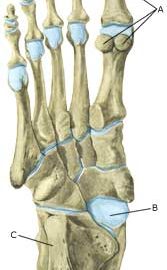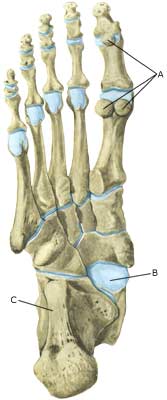|
||
|
||
| Cause: Fracture of the seamoid bones can either occur acutely after sudden forceful strain/load, or in the form of a stress fracture subsequent to repeated, monotonous activity (running).
Symptoms: Pain just below the metatarsophalangeal joint of the big toe which is aggravated when the big toe is flexed backwards. Acute treatment: Click here. Examination: Clinical examination is usually necessary in order to make the diagnosis. The fracture can often be seen on x-rays, MRI examination (article), or ultrasound scanning. Treatment: Treatment of a fracture of the sesamoid bone comprises relief, possibly in the form of shoes with a fixed sole. Rehabilitation: Load or strain within the pain threshold is allowed. Shoes with stiff soles are recommended. The guidelines under rehabilitation, general should be followed. Complications: It is unfortunately often seen that a fracture of the sesamoid bone does not heal, and frequently results in prolonged discomfort. If there is not steady improvement in the condition, consideration must though be given as to whether the diagnosis is correct or whether complications have arisen:
Surgical intervention can be attempted in cases with persistent discomfort, where one of the most used methods entails removal of one part of the fractured sesam bone (article). |


